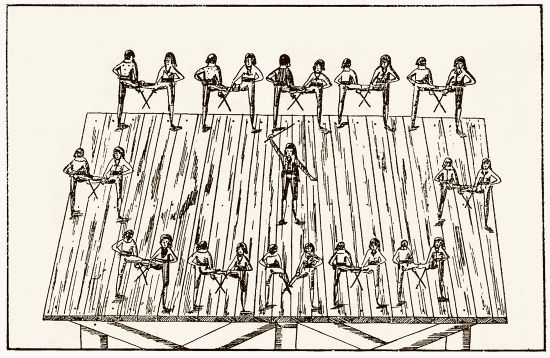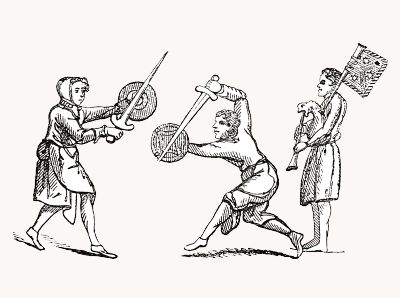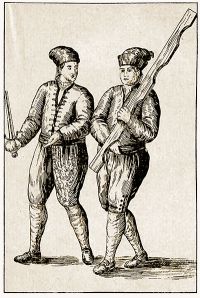

The Castellani & Nicolotti started in 1292 a gang feud in the city of Venice, a rivalry based on competitions of courage, skill, agility and balance and also violence fights.
The map here on the right more or less gives an idea of how the town of Venice was divided in the two factions.
Although both factions were working class, there seems to be a very strong social pattern here: outskirts vs the rich downtown, less paid jobs vs better life standing.
The Castellani - red scarves, battle name: Shrimps - were fishermen and merchandise ferrymen, and originals of the area around San Marco, part of Dorsoduro and Cannaregio, the Lido and Castello, whence the name originates, the downtown area, the rich one.
The Nicolotti - black scarves, battle name: Shadows - came from the East zone of the city - the industrial one - from the area of San Nicolò dei Mendicoli, including Santa Croce, San Polo, and part of Dorsoduro and Cannaregio.
They were initially known as the "Canaruoli e Gnatti", but after the October 31, 1548 extremely bloody fight on the San Barnaba bridge (which they lost) they changed their name in Nicolotti.
The rivalry was kept going and encouraged by the government, because it would keep the men always ready and fit to fight in a war, and also to have at least one of the two factions faithful in case of a conspiracy.
"Per antico essercitio del popolo fu introdotto per decreto pubblico de l’inverno si facesse per i ponti di Venezia, la battagliola cobattendosi l’avantaggio del ponte co’ legni et l’uma delle parti si chiama Castellana e l’altra Nicolotta"
"Because of the traditional people's will, it has been ruled with a public decree, that during winter it could be performed, on Venetian bridges, the little fight using sticks, and one of the factions is the Castellana and the other is the Nicolotta."

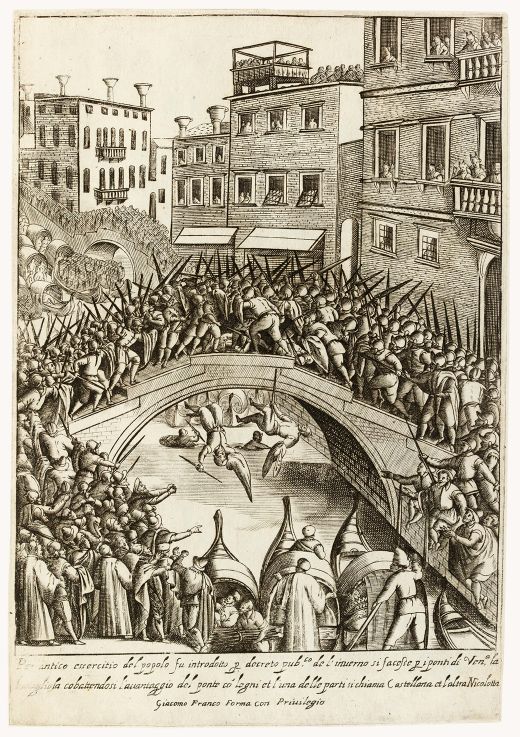
The Forze d’Ercole was how the human pyramid made in Saint Mark’s Square was called, it was a real competition happening every Fat Thursday Carnival and only then, and the Castellani & Nicolotti were taking it very seriously.
It was usually made with a base of 16-20 men, holding strong for another dozen of men that would climb up, and a child on the top saluting the public, the cimiereto (who stays on top) or even with his head down (impalo).
Needless to say accidents happened frequently and the Forze d’Ercole was finally prohibited in 1814.
Giuseppe Remondini: "Le Meravigliose Forze che Sogliano Fare li Castellani il Giovedí Crasso nella Piazza di Venezia" (The marvelous Pyramids which the Castellani usually make on the Fat Thursday in the Square in Venice) - colored etching (mid 18th century)
The "Forze d'Ercole" from a manuscript of the late XVIII century - drawing and watercolor - Museo Bottacin, Padova
Follower of Longhi: portrait of Camillo Albini, executed and offered as a prize for winning the "Forze d'Ercole" of that year - oil on canvas (Beginning 19th century)


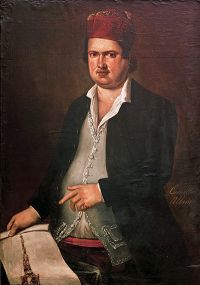
The wars of sticks, held with regularity during the festivities - usually on Sunday afternoons - were quite a violent confrontation, which went on for 413 years in Venice.
On the bridge there could have been 600 fighters, with pointed sticks beating one another for hours. They sometimes had a small round shield (targhe, rotelle) and a cloak (caffettano) or a heavy shirt, rolled around the other arm for protection.
The fight on the Ponte del Carmine in 1574 was probably one of the last with the sticks: by the end of the XVI century the "pugni" fights replaced sticks and canes. No reference found.
Gabriele Bella: "Battle with Sticks on the Ponte Santa Fosca in Venice" - oil on canvas (18th century)
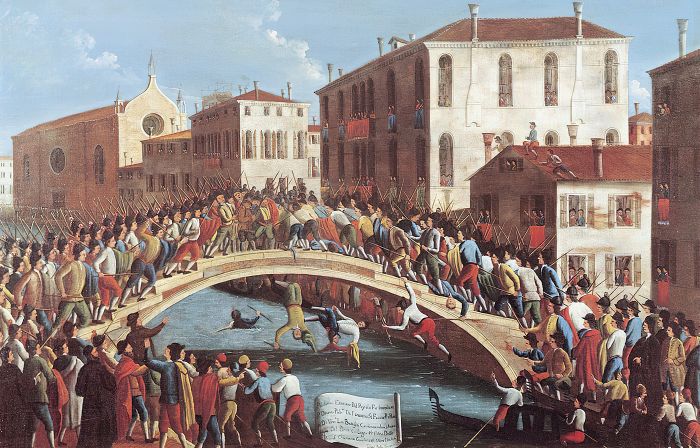
The fights on the Fist Bridge usually happened from September to Christmas, since the beginning of the Castellani & Nicolotti rivalry, in 1292.
It was a basic fist fight done on the bridge nowadays known as “Ponte dei Pugni” (Bridge of the Fists), in which every “team” would fight the hardest possible with their fists only, to throw the opponents in the water, and the bridges for the fights had no side railings ...
The fight ended (or it should've ended ...) when there was blood, or a real heavy injury.
It happened that fights would trascend a little, and in 1705, when knives and rocks were used too, the Serenissima Government put an end to the fist fights emanating a special law.
Anonymous Artist of the Venetian School: "Bridge of the Fists" - oil on canvas (18th century) - Fondazione Musei Civici, Venezia.
Pierre Vander Fleide: "Le pont des combats a coup des points" (The Bridge of fights with the spikes) - "points" instead of poigns, old French I imagine - from the book of Alexandre De Rogissart: "Les delices de l'Italie" (1709) - Biblioteca Forteguerriana, Pistoia
Anonymous Artist: a Nicolotto boxer. Engraving (ca. 18th century).
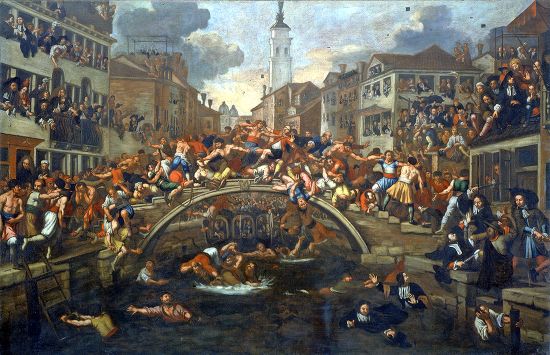

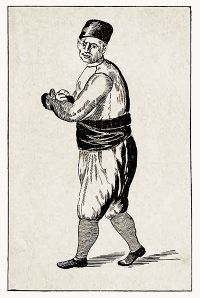
The Moresca was an old dance which very likely originated in Spain in the XII century, depicting in a mock sword combat the idea of the constant threat of Muslim invasion, and the fight against it.
In Italy it arrives around mid XV century, and in 1705 it came up to substitute the other Castellani & Nicolotti confrontations, which were being too violent and bloody, and soon became the symbol of the Carnival dance, associated with the Fat Thursday in the Venetian version.
It was very likely performed on a high stage, by 8 or 12 dancers - usually man but not necessarily – and it is more acrobatic than violent.
The representation made by the Castellani & Nicolotti, in Saint Mark's Square every Carnival, was more a way of performing a less dangerous confrontation among the two feuds, compared to their other manifestations.
Anonymous Artist: "La Moresca un Tempo" (The Moresca in the Past) - engraving.
Anonymous Artist: Sword Dance (13th century) - Royal MS. British Museum.
Anonymous Artist: a Nicolotto carrying his sword for the Moresca dancing, walks with a Castellano carrying a wooden structure which will be used to make the Forze d'Ercole pyramid. Engraving (ca. 18th century).
